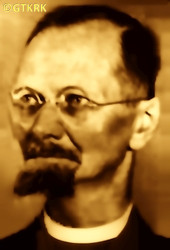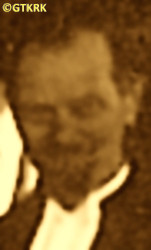Roman Catholic
St Sigismund parish
05-507 Słomczyn
85 Wiślana Str.
Konstancin deanery
Warsaw archdiocese, Poland
full list:
displayClick to display full list

searchClick to search full list by categories
wyświetlKliknij by wyświetlić pełną listę po polsku

szukajKliknij by przeszukać listę wg kategorii po polsku

Martyrology of the clergy — Poland
XX century (1914 – 1989)
personal data
surname
HELDT
forename(s)
Charles Henry (pl. Karol Henryk)
forename(s)
versions/aliases
Karl Heinrich

function
pastor
creed
Lutheran Church LUmore on
en.wikipedia.org
[access: 2014.09.21]
nationality
German
date and place
of death
01.1945

details of death
In 1920, during ministry in Narzym and preparations for the plebiscite, ordered as a result of the arrangements of the Versailles peace treaty ending World War I, which was to decide, among other things, national affiliation of Warmia and Mazury, which took place on 11.07.1920, an activist of pro–German organizations agitating against Poland —– according to other sources, agitated also against Poland in connection with the Polish–Russian war of 1919‐1921, which just then, in 07.1920, was entering a decisive phase (it was the time of Russian invasion ended in 08.1920 with the Russian defeat in the Battle of Warsaw, known as the „Miracle on the Vistula”).
Interned for seven weeks by the Polish authorities in the „camp near Kraków” (prob. in the POWs and Internees Camp No. 1, in the Kraków district of Dąbie).
After release, returned to Narzym — granted to Poland — but after three years, in view of the invariably unfriendly attitude towards Poland, forced to leave the parish.
Moved then to East Prussia in Germany.
After the National Socialist Party (NSDAP) came to power in Germany in 1933, an opponent of the new regime — member of so‐called Confessing Church (Germ. Bekennende Kirche).
In c. 1941/1942 arrested by the German security forces.
Released however though his vicar, pastor Paul Pissowotzki, was sent to the Eastern Front (to the forces fighting at Stalingrad).
Perished at the end of the military conflict of the World War II, started by German and Russian invasion of Poland in 09.1939, during Russian so‐called East Prussian Offensive of 01‐02.1945.
Prob. left Biała Piska with most of the inhabitants — the abandoned village was captured by the Russians on 23.01.1945.
Perished during escape from advancing Russian army, together with his wife, in unknown circumstances.
cause of death
warfare
perpetrators
Russians
sites and events
Ribbentrop‐MolotovClick to display the description, OJiI No. 1 DąbieClick to display the description, Polish‐Ukrainian war of 1918‐1919Click to display the description
date and place
of birth
13.02.1887

Paprotkitoday: Miłki gm., Giżycko pov., Warmia‐Masuria voiv., Poland
more on
en.wikipedia.org
[access: 2022.01.28]
positions held
till 1945
county pastor — Pisztoday: Pisz gm., Pisz pov., Warmia‐Masuria voiv., Poland
more on
en.wikipedia.org
[access: 2023.04.02] ⋄ district seat
1929 – 1945
parish priest — Biała Piskatoday: Biała Piska gm., Pisz pov., Warmia‐Masuria voiv., Poland
more on
en.wikipedia.org
[access: 2023.04.02] ⋄ LU parish
1924 – 1929
parish priest — Kobułtytoday: Biskupiec gm., Olsztyn pov., Warmia‐Masuria voiv., Poland
more on
en.wikipedia.org
[access: 2022.01.28] ⋄ LU parish
1916 – 1923
parish priest — Narzymtoday: Iłowo‐Osada gm., Działdowo pov., Warmia‐Masuria voiv., Poland
more on
en.wikipedia.org
[access: 2023.04.02] ⋄ LU parish
1911 – 1916
parish priest — Białutytoday: Iłowo‐Osada gm., Działdowo pov., Warmia‐Masuria voiv., Poland
more on
en.wikipedia.org
[access: 2021.09.02] ⋄ LU parish
student — Królewiectoday: Królewiec oblast, Russia
more on
en.wikipedia.org
[access: 2022.02.24] ⋄ Department of Theology, Albertus–Universität (Eng. Albert's University), i.e. Albertina
married
others related
in death
BRUNClick to display biography Ginter, MASSOW vonClick to display biography Bertha, ONNASCHClick to display biography Frederick Albert, ONNASCHClick to display biography Frederick Charles Günter
sites and events
descriptions
Ribbentrop‐Molotov: Genocidal Russian‐German alliance pact between Russian leader Joseph Stalin and German leader Adolf Hitler signed on 23.08.1939 in Moscow by respective foreign ministers, Mr. Vyacheslav Molotov for Russia and Joachim von Ribbentrop for Germany. The pact sanctioned and was the direct cause of joint Russian and German invasion of Poland and the outbreak of the World War II in 09.1939. In a political sense, the pact was an attempt to restore the status quo ante before 1914, with one exception, namely the „commercial” exchange of the so‐called „Kingdom of Poland”, which in 1914 was part of the Russian Empire, fore Eastern Galicia (today's western Ukraine), in 1914 belonging to the Austro‐Hungarian Empire. Galicia, including Lviv, was to be taken over by the Russians, the „Kingdom of Poland” — under the name of the General Governorate — Germany. The resultant „war was one of the greatest calamities and dramas of humanity in history, for two atheistic and anti‐Christian ideologies — national and international socialism — rejected God and His fifth Decalogue commandment: Thou shall not kill!” (Abp Stanislav Gądecki, 01.09.2019). The decisions taken — backed up by the betrayal of the formal allies of Poland, France and Germany, which on 12.09.1939, at a joint conference in Abbeville, decided not to provide aid to attacked Poland and not to take military action against Germany (a clear breach of treaty obligations with Poland) — were on 28.09.1939 slightly altered and made more precise when a treaty on „German‐Russian boundaries and friendship” was agreed by the same murderous signatories. One of its findings was establishment of spheres of influence in Central and Eastern Europe and in consequence IV partition of Poland. In one of its secret annexes agreed, that: „the Signatories will not tolerate on its respective territories any Polish propaganda that affects the territory of the other Side. On their respective territories they will suppress all such propaganda and inform each other of the measures taken to accomplish it”. The agreements resulted in a series of meeting between two genocidal organization representing both sides — German Gestapo and Russian NKVD when coordination of efforts to exterminate Polish intelligentsia and Polish leading classes (in Germany called «Intelligenzaktion», in Russia took the form of Katyń massacres) where discussed. Resulted in deaths of hundreds of thousands of Polish intelligentsia, including thousands of priests presented here, and tens of millions of ordinary people,. The results of this Russian‐German pact lasted till 1989 and are still in evidence even today. (more on: en.wikipedia.orgClick to attempt to display webpage
[access: 2015.09.30])
OJiI No. 1 Dąbie: POWs and Internees Camp No. 1, in the Kraków district of Dąbie — one of the internment camps, during the Polish–Ukrainian war of 1918‐1919, the Polish–Czech conflict of 1919 and the Polish–Russian war of 1919‐1921 — for prisoners captured by the Polish Army, i.e. Ukrainians, Czechs, Russians. Established in 11.1918 on the site of a POW camp of the former Austro–Hungarian Empire. At its peak, in 03.1920, the camp held 4,987 people. Epidemics of typhus and dysentery broke out in the camp several times: e.g. in 12.1918, 02.1919. During the three years of the camp's existence, 1,104 people died there. Liquidated on 06.12.1921. (more on: dabiehistoria.blogspot.comClick to attempt to display webpage
[access: 2025.03.07])
Polish‐Ukrainian war of 1918‐1919: One of the wars for borders of the newly reborn Poland. At the end of 1918 on the former Austro‐Hungarian empire’s territory, based on the Ukrainian military units of the former Austro‐Hungarian army, Ukrainians waged war against Poland. In particular attempted to create foundation of an independent state and attacked Lviv. Thanks to heroic stance of Lviv inhabitants, in particular young generation of Poles — called since then Lviv eaglets — the city was recaptured by Poles and for a number of months successfully defended against furious Ukrainian attacks. In 1919 Poland — its newly created army — pushed Ukrainian forces far to the east and south, regaining control over its territory. (more on: en.wikipedia.orgClick to attempt to display webpage
[access: 2017.05.20])
sources
personal:
www.ostpreussen.netClick to attempt to display webpage
[access: 2013.08.10], docplayer.plClick to attempt to display webpage
[access: 2023.04.02]
original images:
epdz.powiatdzialdowski.plClick to attempt to display webpage
[access: 2023.04.02], www.schuka.netClick to attempt to display webpage
[access: 2013.12.04]
LETTER to CUSTODIAN/ADMINISTRATOR
If you have an Email client on your communicator/computer — such as Mozilla Thunderbird, Windows Mail or Microsoft Outlook, described at WikipediaPatrz:
en.wikipedia.org, among others — try the link below, please:
LETTER to CUSTODIAN/ADMINISTRATORClick and try to call your own Email client
If however you do not run such a client or the above link is not active please send an email to the Custodian/Administrator using your account — in your customary email/correspondence engine — at the following address:

giving the following as the subject:
MARTYROLOGY: HELDT Charles Henry
To return to the biography press below:
 Click to return to biography
Click to return to biography









